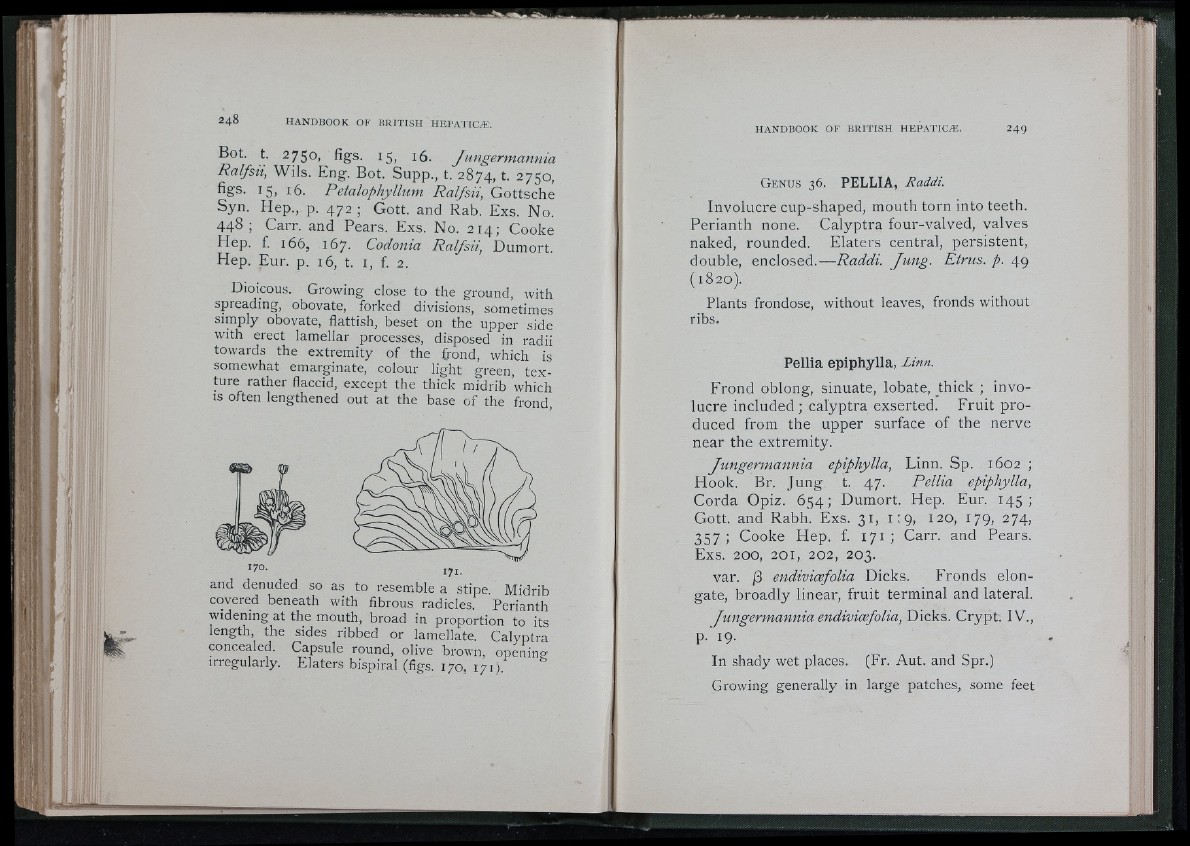
HANDBOOK OF BRITISH HEPATICÆ.
Eofi t. 2750,^ figs. 15, 16. Jungermannia
Ralfsii, Wi ls . Eng. Bot. Supp., t. 2874, t. 2750,
figs. 15, 16. Petalophyllum Ralfsii, Got ts che
Syn. Hep., p. 472 ; Gott. and Rab. Exs. No.
448 ; Carr, and Pears. Exs. No. 2 14 ; Cooke
Hep. f. 166, 167. Codonia Ralfsii, Dumort.
Hep. Eur. p. 16, t. i , f. 2.
DioRous. Growing close to the ground, with
spreading, obovate, forked divisions, sometimes
simply obovate, flattish, beset on the upper side
with erect lamellar processes, disposed in radii
towards the extremity of the frond, which is
somewhat emarginate, colour light green, tex ture
rather flaccid, except the thick midrib ’which
IS often lengthened out at the base 01 the frond,
170.
and denuded so as to resemble a stipe Midrib
covered beneath with fibrous radicles. Perianth
widening at the mouth, broad in proportion to its
length, the sides ribbed or lamellate. Calyptra
concealed. Capsule round, olive brown, openino-
irregularly. Elaters bispiral (figs. 170, 171).
G en u s 36. PELLIA, Raddi.
Involucre cup-shaped, mouth torn into teeth.
Per ianth none. C a lyp t ra four-valved, valve s
naked, rounded. Elaters central, persistent ,
double, enclosed.— Raddi. Ju n g . Etrus. p. 49
(1820).
Plants frondose, without leaves, fronds w'ithout
ribs.
Pellia epiphylla, Linn.
Frond oblong, sinuate, lobate, thick ; invo lucre
included ; calypt ra exserted. Frui t produced
from the upper surface of the nerve
near the extremity.
Jungermannia epiphylla, Linn. Sp. 1602 ;
Hook. Br. Jung t. 47. P e llia epiphylla,
Co rd a Opiz. 6 5 4 ; Dumort. Hep. Eur. 1 4 5 ;
Gott. and Rabh. Exs. 31, 1 :9 , 120, 179, 274,
357 ; Co o ke Hep. f. 17 1 ; Carr, and Pears.
Exs. 200, 201, 202, 203.
var. j3 endivicefolia Dicks. Fronds elongate,
broadly linear, fruit terminal and lateral.
Jungermannia endivicefolia, Dicks. Crypt . IV.,
p. 19.
In shady wet places. (Fr. Aut. and Spr.)
Growing generally in large patches, some feet